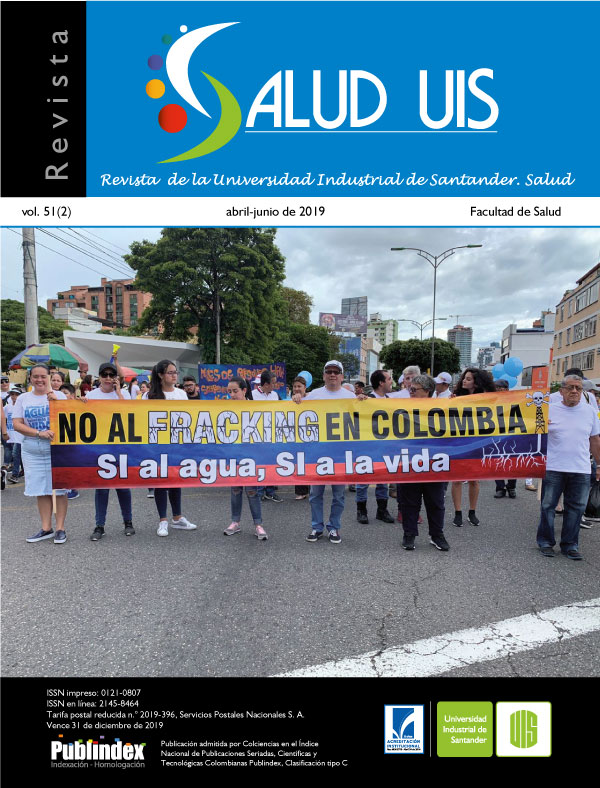Referencias
1. Gallegos TJ, Varela BA, Haines SS, Engle MA. Hydraulic fracturing water use variability in the United States and potential environmental implications, Water Resour Res. 2015; 51: 5839-5845. doi:10.1002/2015WR017278.
2. Howarth RW, Ingraffea A, Engelder T. Natural gas: Should fracking stop? Nature. 2011; 477(7364): 271-275. doi: https://doi.org/10.1038/477271a.
3. Watterson A, Dinan W. Public health and unconventional oil and gas extraction including fracking: global lessons from a Scottish government review. Int J Environ Res Public Health. 2018; 15(4): E675. doi: https://10.3390/ijerph15040675.
4. Li L, Tan J, Wood DA, Zhao Z, Becker D, Lyu Q, et al. A review of the current status of induced seismicity monitoring for hydraulic fracturing in unconventional tight oil and gas reservoirs. Fuel. 2019; 242: 195-210.doi: https://doi.org/10.1016/j.fuel.2019.01.026.
5. Warpinski NR, Du J, Zimmer U. Measurements of hydraulic-fracture-induced seismicity in gas shales, SPE Hydraul. Fract Technol Conf., SPE 151597, The Woodlands, Texas. 2012; 1-8: doi: 10.2118/151597-PA.
6. Idrovo AJ. Terremotos, huracanes y salud humana: un llamado a estar listos. Rev Univ Ind Santander. Salud
2017; 49(4): 517-518.
7. Richburg CM, Slagley J. Noise concerns of residents living in close proximity to hydraulic fracturing sites in
Southwest Pennsylvania. Public Health Nurs. 2019; 36(1): 3-10. doi: https://10.1111/phn.12540.
8. McMullin TS, Bamber AM, Bon D, Vigil DI, Van Dyke M. Exposures and health risks from volatile organic
compounds in communities located near oil and gas exploration and production activities in Colorado (U.S.A.).
Int J Environ Res Public Health. 2018; 15(7): E1500. doi: https://10.3390/ijerph15071500.
9. Paulik LB, Hobbie KA, Rohlman D, Smith BW, Scott RP, Kincl L, et al. Environmental and individual
PAH exposures near rural natural gas extraction. Environ Pollut. 2018; 241: 397-405. doi: https://10.1016/j.
envpol.2018.05.010.
10. Hu G, Kaur M, Hewage K, Sadiq R. Fuzzy clustering analysis of hydraulic fracturing additives for environmental
and human health risk mitigation. Clean Techn Environ Policy. 2019; 21(1): 39-53. doi: https://doi.org/10.1007/
s10098-018-1614-3.
11. Currie J, Greenstone M, Meckel K. Hydraulic fracturing and infant health: New evidence from Pennsylvania.
Sci Adv. 2017; 3(12): e1603021. doi: https://10.1126/sciadv.1603021.
12. Peng L, Meyerhoefer C, Chou SY. The health implications of unconventional natural gas development in
Pennsylvania. Health Econ. 2018; 27(6): 956-983. doi: https://10.1002/hec.3649.
13. Denhama A, Willis M, Zavez A, Hill E. Unconventional natural gas development and hospitalizations:
evidence from Pennsylvania, United States, 2003–2014. Public Health 2019; 168: doi: 17-25. https://10.1016/j.
puhe.2018.11.020.
2. Howarth RW, Ingraffea A, Engelder T. Natural gas: Should fracking stop? Nature. 2011; 477(7364): 271-275. doi: https://doi.org/10.1038/477271a.
3. Watterson A, Dinan W. Public health and unconventional oil and gas extraction including fracking: global lessons from a Scottish government review. Int J Environ Res Public Health. 2018; 15(4): E675. doi: https://10.3390/ijerph15040675.
4. Li L, Tan J, Wood DA, Zhao Z, Becker D, Lyu Q, et al. A review of the current status of induced seismicity monitoring for hydraulic fracturing in unconventional tight oil and gas reservoirs. Fuel. 2019; 242: 195-210.doi: https://doi.org/10.1016/j.fuel.2019.01.026.
5. Warpinski NR, Du J, Zimmer U. Measurements of hydraulic-fracture-induced seismicity in gas shales, SPE Hydraul. Fract Technol Conf., SPE 151597, The Woodlands, Texas. 2012; 1-8: doi: 10.2118/151597-PA.
6. Idrovo AJ. Terremotos, huracanes y salud humana: un llamado a estar listos. Rev Univ Ind Santander. Salud
2017; 49(4): 517-518.
7. Richburg CM, Slagley J. Noise concerns of residents living in close proximity to hydraulic fracturing sites in
Southwest Pennsylvania. Public Health Nurs. 2019; 36(1): 3-10. doi: https://10.1111/phn.12540.
8. McMullin TS, Bamber AM, Bon D, Vigil DI, Van Dyke M. Exposures and health risks from volatile organic
compounds in communities located near oil and gas exploration and production activities in Colorado (U.S.A.).
Int J Environ Res Public Health. 2018; 15(7): E1500. doi: https://10.3390/ijerph15071500.
9. Paulik LB, Hobbie KA, Rohlman D, Smith BW, Scott RP, Kincl L, et al. Environmental and individual
PAH exposures near rural natural gas extraction. Environ Pollut. 2018; 241: 397-405. doi: https://10.1016/j.
envpol.2018.05.010.
10. Hu G, Kaur M, Hewage K, Sadiq R. Fuzzy clustering analysis of hydraulic fracturing additives for environmental
and human health risk mitigation. Clean Techn Environ Policy. 2019; 21(1): 39-53. doi: https://doi.org/10.1007/
s10098-018-1614-3.
11. Currie J, Greenstone M, Meckel K. Hydraulic fracturing and infant health: New evidence from Pennsylvania.
Sci Adv. 2017; 3(12): e1603021. doi: https://10.1126/sciadv.1603021.
12. Peng L, Meyerhoefer C, Chou SY. The health implications of unconventional natural gas development in
Pennsylvania. Health Econ. 2018; 27(6): 956-983. doi: https://10.1002/hec.3649.
13. Denhama A, Willis M, Zavez A, Hill E. Unconventional natural gas development and hospitalizations:
evidence from Pennsylvania, United States, 2003–2014. Public Health 2019; 168: doi: 17-25. https://10.1016/j.
puhe.2018.11.020.

Esta obra está bajo una licencia internacional Creative Commons Atribución 4.0.
Descargas
Los datos de descargas todavía no están disponibles.
